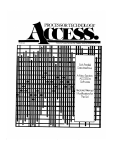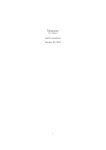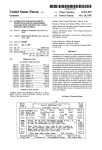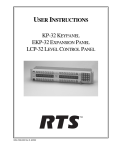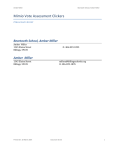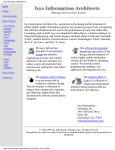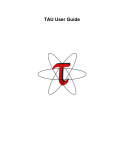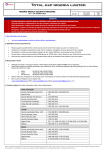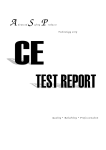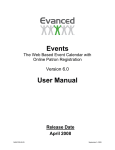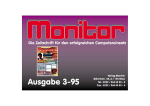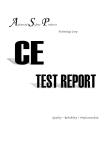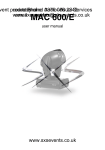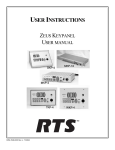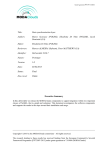Download llllllllllllll1|Illllllllllljllllll|||||lllllllllllllllllllllllllllllllll
Transcript
l l l l l l l 1|Il l l l l ljl l l | | |l l l l l l l l l l l l l l l l l
005283856A
I
Ulllt?d States P?t?llt [19]
[11] Patent Number:
Gross et a1.
[45]
[54]
EVENT-DRIVEN RULE-BASED MESSAGING
4,924,408 5/ 1990 Highland ........................... .. 364/513
SYSTEM
4,931,933 6/1990
4,937,036 6/1990
4,939,507 7/1990
[75] Inventors: Kevin C. Gross, Belmont; Charles J.
Digate, Boston; Eugene H. Lee,
4,949,278 8/1990
_
5,063,523 11/1991
[73] Ass1gnee: Beyond, Inc., Cambndge, Mass.
5,103,493 4/1992
_
5,165,011 11/1992
[21] Appl. No.. 771,197
[22]‘ F?ed'
5,204,939 4/1993
Oct‘ 4’ 1991
OTHER PUBLICATIONS
Céis ....................................... ..5;.5/G06s1_F39155//51O8'
.
Q
Q
Kmtemann et a1” uprocesyorjemcd Mode] Imegra_
a I n u I I o a n I n n a u u a 0 u 0 n 0 v - n o n u a u 6 - I 6 a n n 0 c v- 395/60; ’ 395/9251
[58] Field 61 Search
tlon”,
-
395/51 61 68 925
sc‘ems’ 5'8 Jan‘ 1988’ 396402‘
"""""""""" " 395/92’6 7’6 _;7 12’
’
[56]
’
’
mological Signal Understanding”, 1989 Intl. Conf. on
Acoutics, Speech and Signal Processing, 23-26 May
U.S. PATENT DOCUMENTS
1989' MM"
4106060 8/1978 Chapman .11‘
358/256
4:532:588 7/1985 Foster
4,558,413 12/1985 5611611616431.
-
Roberto et al., “A Knowledge-Based System for Seis
References Cited
4,646,235 2/1987 Hirosawa C181. .
.. 264/900
4,658,370
4/1987
Erman et a1. ..
.. 364/513
4,713,780 12/1987 Schultz et al. .
.. 364/514
-.
P’ima’J’Ex‘1mi"e"-Mi°ha°1 R- Fleming
AS$iSmmEmmin€r—R0bm W- Downs
Attorney. Agent, or Firm—Weingarten, Schurgin,
364/200
3/1987 Foster ............. ..
.
(List commued on next Page.)
""""""""" "I 364/200
364/300
4,648,061
21512:; 1%;
Feb. 1, 1994
4,941,170 7/1990
Cambridge, all of Mass.
,
Date of Patent:
5,283,856
Gagnebin & Hayes
[57]
ABSTRACT
A ?exihle, event driven and conditional rule based mail
3:532? ---- -
417341931 3/1988 Bourg 6111:.
379/93
messagmg systei“ whlch ".a“ b? "ansParsmly ‘mple'
4,763,277 8/1988 Ashford ct 3L
364/513
mented for use 1n electromc mall apphcations. A rule
4,763,144
4,805,207
4,809,219
418271413
8/1988
2/1989
2/1989
5/1939
wimcr e, a].
McNun et a1,
Ashford et a1.
Gerstenfeld
364/200
379/s9
364/900
364/439
mechanism is implemented having a “When-If-Then”
event-driven, conditional, action-invoking paradigm or
“triplet” which permits de?nition of a repertoire of
4:849:878
7/1989
Roy ......... ..'...'.' . . . .
' ‘ ' “364/200
‘"1" Each Particular event may be assc’ciated with a
4,860,352 3/1989 Laurance et a1. ‘
4,866,634 9/1989 RCbOh et al. .... ..
380/23
364/513
speci?c mail message and/or rules to promote efficient
mapping of messages, events and rules so that only 111198
4,876,711 10/1989 Curtin .......... ..
events considered to be signi?cant events upon which
to trigger actions in the electronic mail messaging sys
379/94
associated with a speci?c event are invoked upon oc
91 al-
364/300
currence of the event. Only relevant rules, i.e. those
418841217 11/1989 Skunk 9‘ a1‘ --
364/513
associated with a satis?ed event, need be further pro
4,879,643 11/ 1989
z’ggglggg
1152:: Z:
cessed. A graphical user interface to a structured rule
4:899:136 2/1990 Beard et aL
340/706
editor facilitates synthesis of rules by a user via a sub
4,902,881
2/1990 Janku ....... ..
235/381
Stamially transparent r1119 engine
4,912,648
3/ 1990 Tyler ............ ..
364/5l3
4,914,590 4/1990 Loatman et a1.
364/419
4,918,588 4/1990 Barrett et a1. ..................... .. 364/200
33343712747117
19 Claims, 9 Drawing Sheets
m ”
llfil/ll'f
52
ll!!!
5,283,856
Page 2
OTHER PUBLICATIONS
Rosenblitt, D.; and Card, S. K., “How Do Experienced
Ayre, R., “Evolving E-Mail: Will Client/Server Get
The Message?”, PC Magazine, Sep. 10, 1991, p. 322(2).
Dutta, S., “An Event Based Fuzzy Temporal Logic”,
Proc. 18th Intl. Symp. on Multiple Valued Logic, May
ACM (Association for Computing Machinery), CHI‘89
Proceedings, May 1989, pp. 211-216.
Malone, T. W.; Grant, K. R.; Lai, K. Y.; Rao, R.; and
1988, 64-71.
gent System for Information Sharing and Coordina
tion,” Technological support for work group collarbora
Information Lens Users Use Rules?” Copyright 1989
,
Arcidiacono, T., “Expert System On-Call”, PC Tech
Journal, Nov. 1988, 112-116, 118, 120, 122, 124, 126,
128, 130, 134, 135.
Overton et al., “A Fuzzy Representation for Event
Occurrence”, SPIE vol. 1198 Sensor Fusion 11: Human
and Machine Strategies, 1989, 472-479.
Perkins et al., “Adding Temporal Reasoning to Exper
t-System-Building Environments”, IEEE Expert, Feb.
1990, 23-30.
Amadi, Dr. A. 0., “Automatic Filing and Retrieval of
Official Messages Using Global Mail Attributes and a
Rosenblitt, D. A., “The Information Lens: An Intelli
tion, M. H. Olson (Ed), Hillsdale, N.J.: Lawrence Erl
baum Associates, 1989, pp. 65-88.
Malone, T. W.; Grant, K. R.; Turbak, F. A.; Brobst, S.
A.; and Cohen, M. D., “Intelligent Information-Shar
ing Systems,” Communications of the ACM, May 1987,
vol. 30, No. 5, pp. 390-402.
Malone, T. W.; Grant, K. R.; Lai, K. Y.; Rao, R.; and
Rosenblitt, D., "Semistructured Messages Are Surpris
ingly Useful for Computer-Supported Coordination,”
Research Contributions, ACM Transactions on Office
Viewdata System with Symbolically Names Pages,”
Office Information Systems, Oct. 1988, pp. 11-18.
Information Systems, vol. 5, No. 2, Apr. 1987, pp.
Crowston, K. and Malone, T. W., “Intelligent Software
Agents,” Byte, Dec. 1988, pp. 267-271.
Marshak, D. S., “Filters: Separating the Wheat from the
115-131.
Chaff,” Patricia Seybold’s Office Computing Report, vol.
Gold, E., “ETC: an A1 Based Electronic Mailer,” Re
13, No. 11, Nov. 1990, pp. l-8.
search Notes, Computer Research Laboratory, Tek
tronix, Inc., P.O. Box 500, MS 50-662, Beaverton,
Oreg. 97077, Draft-Jun. 28, 1985, pp. 1-15 plus 10 pages
consisting of References, List of Figures, and List of
Tables.
Greif, I. and Satin, 8., “Data Sharing In Group Work,”
Pollock, S., “A Rule-Based Message Filtering System,”
ACM Transactions on Office Information Systems, vol. 6,
Massachusetts Institute of Technology, Laboratory for
24, 1991, individually listed and identi?ed as items #1
through #33 on cover sheet entitled “Appendix A”.
Product brochure entitled “BeyondMail Personal Pro
Computer Science, Oct. 1986, pp. 1-10. (Note: this paper
was to have appeared in in Proceedings of Conference
on Computer-Supported Cooperative Work, Dec. 3-5,
1986, Austin, Tex.)
Lai, K. Y., Malone, T. W., and Yu, K. C., “Object Lens:
A ‘Spreadsheet’ for Cooperative Work,” ACM Transac
tions on Office Information Systems, 1988, pp. 1-28, plus
FIGS. 1-11.
Lee, J. and Malone, T. W., “Partially Shared Views: A
Scheme for Communicating among Groups that Use
Different Type Hierarchies,” ACM Transactions on
Information Systems, vol. 8, No. 1, Jan. 1990, pp. 1-26.
Mackay, W. E.; Gardner, B. R.; Mintz, T. H.; Pito, R.
A.; and Siegal, J. B., “Argus Design Speci?cation,”
Copyright 1989 Massachusetts Institute of Technology,
Draft: 17 Oct. 1989, pp. 1-50.
Mackay, W. E.; Malone, T. W.; Crowston, K.; Rao, R.;
No. 3, Jul. 1988, pp- 232-254.
Press releases, newspaper and magazine articles, and
prepublication research notes relating to Beyond, Inc.,
and BeyondMail, dated between Oct. 17, 1989, and Sep.
ductivity Tool,” Copyright 1991 Beyond Incorporated,
consisting of one two-sided page.
Product brochure entitled “BeyondMail Electronic
Mail for Productive Workgroups,” by Beyond Incorpo
rated, consisting of cover page and 6 pages of informa
tion (undated).
Putz, S., “Babar: An Electronic Mail Database,” Copy
right 1988 Xerox Corporation, Palo Alto, Calif, Xerox
Parc, SSL-88-1, Apr. 1988, pp. 1-17, with attached
Babar User Guide, pp. l-30.
Rosenberg, J., Everhart, C. F., and Borenstein, N. S.,
“An Overview of the Andrew Message System,” Jul.
1987,
Copyright
1988
ACM
0-897
91-245=4/88/O001/O099, pp. 99-108.
US. Patent
Feb. 1, 1994
Sheet 1 of 9
(ll/5)
If"'01?!
64671 / fIf5
(005)
FIG. 1
W1 [5
AW
Wu”
[mm/w
mm mm
M‘”
Wm
If! 1555,46? H’fl/
FIG. 3A
FIG. 2
US. Patent
Feb. 1, 1994
Sheet 2 of 9
5,283,856
FIG. 3B
Ill/H3017!‘ J m"
'
5
#555405;
‘_____
FIG. 3C
1059/0” .-
Mlf: __________l
%—
FIG. 3D
FIG. 3B
US. Patent
Feb. 1, 1994
Sheet '3 of 9
5,283,856
STAR/0P [VH7
FIG. 3F
FIG. 36
MUM/5) [Vf/W
191/! f [5/
0. l. I s EMU/[ff]?
Iii/1f.
FIG. 3H
1.4.6‘. Mill/[759:
FIG. 31
US. Patent
Feb. 1, 1994
Sheet 4 of 9
I
[VF/W
arm/[sum
w,
4
l
[VH7
Mum’
"'24
FIG. 3J
5,283,856
US. Patent
Feb. 1, 1994
mm; 5m; mm
muff, #m r, mm”
Sheet 6 of 9
5,283,856
f”
1/55?
I
MIN/"46f
0754/? #m/M
V
L———_Wm
‘
24)
7mm
rm
55%’
__-_->’'[’'’ com/7m ‘Mb ANN/I5
AL
mm;
P
mm;
0555
mm mm
mmf 5m; mm
Mari, mu mm/m
mm”, 0mm,
/h
v
f/ZfS,
‘
50
[-IM/Z m M W67 05
mm‘
HMS/055ml
l l
Mum/r
mama, 1mm‘,
"/1"5
#mm/r/r m5
F]G. 6
MW 70/010517: M50)’
FIG. 7
US. Patent
m!
Feb. 1, 1994
Mm’ m0 ' $ #3540; ///
Sheet 8 of 9
mm
5,283,856
mm
/f
L:
gm m: m‘.- sum/m
mm
FIG. 10A
4)_- >
Um il/lf m‘.- m/mm
m”
)
FIG. 10B
1
5,283,856
2
lected information from the semi-structured objects in
EVENT-DRIVEN RULE-BASED MESSAGING
SYSTEM
FIELD OF THE INVENTION
table or tree formats. A template-based user interface,
permits users to interface with an object-oriented data
base to see and change objects via interaction with
familiar forms or templates. The user, via the templates,
The present invention relates to an electronic mail
messaging system and in particular to a rule based sys
constructs conditional rules comprising “If” conditions,
which upon satisfaction “Then” result in user-speci?ed
tem and rule editor for directing messages in the elec
actions taking place in accordance with the specified
rule(s). The “If-Then” rules can be used to group ob
tronic mail messaging system. '
BACKGROUND OF THE INVENTION
Rule-based systems are known which use rules, typi
cally "If-Then” sequences, to automatically process or
"filter” signal groups transmitted as messages in a com
puter environment or network. Such systems are gener
10 jects together and can be automatically invoked as
“semi-autonomous agents" or methods invoked by the
system without user intervention, speci?ed by the user
to process information in different ways. Users can
ally implemented, via object oriented programming
techniques, in the context of electronic mail facilities.
The application of rules or the occurrence of an action
is triggered upon selected criteria being met, i.e. match
ing of electronically established criteria occurring in a
received electronically mailed message. Upon the oc
currence of a received and stored mail message satisfy
ing speci?ed conditional criteria set forth in the “If’
portion of the statement, such as the mail message being
20
create these rule-based agents to be triggered upon the
condition of an occurrence, in particular upon receipt of
a new mail message. Upon the “If” portion of the rule
being satis?ed, a further set of rules is applied to a speci
?ed collection of objects, semi-autonomously (i.e., auto
matically but under control by a human user).
However, limited ?exibility is provided by this sys
tem which only tests occurrences as a conditional (“If”)
component of a rule. Considerable complexity and inef
?ciency is also inherent in the system which requires
compound conditions (“Ifs”) for event triggering, be
addressed from a selected addressor, the “THEN” por 25 cause in addition to every mail message being tested for
tion of the rule or rule set will invoke some action, in
an occurrence or event which satis?es a ?rst rule, the
some instances directing signal groups comprising the
mail messages must be further tested for other criteria to
mail message to a designated file or user area. In known
systems, the “If-Then” sequences can be constructed
using connectors and Boolean operators resulting in
relatively complex combinations within and among
?elds of the sequence.
In one system (ISCREEN), described in A Rule
Based Message Filtering System by Stephen Pollock
published in ACM Transactions on Of?ce Information
Systems, Vol. 6, No. 3, July 1988, pages 232-254, elec
tronic text mail messages are screened, decisions are
made and actions taken in accordance with rules de?n
ing procedures typically implemented as part of the
manual processing of information generated in an of?ce.
A user invokes a rule editor to create rules for provid
be satis?ed before invoking the action (“Then”) portion
of the rule.
In addition to having limited event driven capability
that results in in?exible and inef?cient processing of
mail messages, and requiring a user to learn fairly com
plex rule design and construction schemes, known sys
tems do not have a capability to invoke or “launch”
known applications via an event selective rule mecha
nrsm.
SUMMARY OF THE INVENTION
The present invention provides a ?exible, efficient,
event-driven and conditional rule-based system which
can be transparently implemented for use, e.g. in elec
ing instructions to the system. The rules include condi
tronic mail applications.
tions which describe values associated with attributes of
A rule mechanism is implemented having a “When
a mail message, such as who the mail message is from
and/or what it is about. The rules created by the user 45 If-Then” event-driven, conditional, action-invoking
paradigm or “triplet” which facilitates de?nition of a
further include actions which describe what is to be
repertoire of events considered to be signi?cant events
done with mail messages that match the user speci?ed
conditions. Typical actions, which in this known imple
mentation are functions of the underlying mail messag
upon which to trigger actions in a system such as an
electronic mail messaging system. Particular events
ing system, include forwarding, ?ling and deleting the
mail message(s).
50 may be associated with a speci?c mail message, and/or
A special purpose editor invoked by the user to de?ne
events, and rules, so that only rules which monitor a
speci?c event are invoked upon occurrence of the
event. Thus, only mail messages and relevant rules (i.e.,
those having an associated satis?ed event) need be fur
rules, disadvantageously requires that a specific rule
rule(s), to promote efficient mapping of messages,
format be learned and adhered to by the user. Speci?ed
rules can only be triggered on matching mail message 55
ther processed.
criteria and cannot be triggered based upon the timing
Further, a graphical interface is presented to the user
of an event, such as the expiration of a time interval.
Further, the system requires extensive parsing of user
speci?ed instructions to detect instruction con?icts,
completeness and consistency.
to permit “point and click” or cursor controlled synthe
sis or design and invocation of an underlying structured
rule editor or rule set(s), via a substantially user trans- ,
Another known system (Object Lens), disclosed in
parent rule mechanism. The user can invoke structured
Object Lens: A ‘Spreadsheet’ for Cooperative Work, by
rules and rule sets without learning a complex rule lan
guage and editor.
Still further, the rule mechanism has a capability to
Kum-Yew Lai et a1 published in ACM Transactions on
Of?ce Information Systems, 1988, provides various
templates for various semi-structured objects which
users de?ne and modify to represent information about,
among other things, people, tasks, products, and mail
messages. Users can create displays to summarize se
65 permit a user to invoke or “launch” a concurrent pro
cess or application from within the event selective rule
mechanism. The action or THEN portion of a rule can
specify a launch verb which provides a springboard to
3
5,283,856
off-the-shelf application software, such as a spreadsheet
program, word processor or the like, permitting the
user to launch automatically into the application via the
rule mechanism and to automatically re-enter the mes
4
tronic mail application. The rule based messaging mech
anism 10 is accessible to a user through a user interface
14, such as templates as known in the art or through a
Features of the invention include a simple user inter
graphical user interface as described hereinafter.
In one embodim‘ent, as illustrated in FIG. 2, a client
server architecture is implemented. Various rule mech
face to an ef?cient, powerful and sophisticated rule
based messaging system. While simple user interfaces
by a messaging transport access layer 16. In conjunction
are available which synthesize-rules via the underlying
with an integral electronic mail driver component 18
saging system from the launched application.
structured rule editor, rule syntax permits external text
editors to be used to create interfaces for importation
into the system. Other features and aspects of the inven
tion are explained in BEYONDMAIL Electronic Mail
for Productive Workgroups: Rule Book; User Guide;
and Administration Guide, which are incorporated
herein by reference.
DESCRIPTION OF THE DRAWINGS
These and other features and advantages of the pres
ent invention will become more apparent in light of the
following detailed description of an illustrative embodi
ment thereof, as illustrated in the accompanying draw
ings of which:
FIG. 1 is a simpli?ed block diagram of components of
anism resources 13 and the user interface 14 are served
available to the rule based messaging mechanism 10, the
message transport access layer 16 serves as an applica
tion program interface which integrates the rule mecha
nism 10 with the particular electronic mail application
running with the network software, facilitating mail
message access between the rule mechanism resources
13 and the electronic mail application.
The rule mechanism resources 13 implement actions
on a mail message (i.e. cause something to be done)
based upon an evaluation of a condition, effected upon
the occurrence of a particular event. The structure of
every rule, whether user speci?ed or invoked under a
graphical user interface, can be diagrammed as:
WHEN(event)-+IF(condition)—’TI{EN(action).
25
a rule based message handling system;
FIG. 2 is a diagrammatic representation of a client
The WHEN event ?eld permits speci?cation of classes
server implementation of the rule based message han
of occurrences and/or various types of mail messages
dling system of FIG. 1;
which will invoke the rule de?ned in the corresponding
FIGS. 3a-3h are illustrations of data structures for
IF(condition)->THEN(action) ?elds of a speci?ed rule.
implementing a event component of a rule in the rule 30 Events trigger the processing of conditions and actions
based messaging system of FIG. 1;
FIG. 31' and 3j are a block diagram of an inter-applica
tion communication event data structure and associated
block diagram, respectively;
and enable ef?cient mapping of messages, events and
rules.
The events may be a function of a timer integral with
the system, or a function of a folder destination of a
FIG. 4 is a diagrammatic representation of an event 35 particular message, or a function of the form of a mail
selective rule mechanism of the message handling sys
message according to the mail messaging system. Vari
tem of FIG. 1;
ous events can be speci?ed to trigger evaluation of a
FIG. 5 is a block diagram of the event mechanism of
condition and invocation of corresponding actions.
the rule based message handling system of FIG. 1;
Preferably event types will accommodate respective
FIG. 6 is a system overview block diagram of the rule 40
operands
to permit further speci?cation of relevant
based message handling system of FIG. 1;
messages to be considered for rule invocation, to further
FIG. 7 is a graphic user interface for a tickle feature
enhance the efficiency of the rule mechanism. Event
implementing a structured rule editor;
types are created and processed by an event manager
FIG. 8 is a diagrammatic representation of a tickler
graphical user interface and associated event data struc 45 using a common set of data structures and routines.
ture;
A NEW message event type (WI-[EN NEW), is used
to specify application of rules to a new message which
FIG. 9 is a block diagram of the rule based system of
FIGS. 4 and 5 effecting a tickler feature as depicted in
has been received by the electronic mail application
1, is implemented in computer based systems and typi
cally in networked personal computer systems. The
processed as discussed hereinafter.
over a network mail transport agent (MTA) and placed
FIG. 8;
FIGS. 10a and 10b are illustrations of form mode and 50 in a message store. Upon receipt of a message packet
from the MTA over the network interface (i.e. a NEW
text mode formats for creating rules, respectively;
message), a NEW message event is created by the event
FIG. 10c is a block diagram of an external structured
manager, according to a data structure illustrated in
rule editor mode for rule creation; and
FIG. 3a. The NEW message event is created indicating
FIG. 11 and 110 are a graphical user interface and
underlying structured rule, respectively, for an “out of 55 the date and time of receipt of the new message. A
message identi?er or unique identi?er (UID) is included
the of?ce function".
in the NEW event to point to the message (which may
DETAILED DESCRIPTION
be stored using the host operating system ?ling facili
ties) associated with the NEW message event. The
A rule based messaging system, as illustrated in FIG.
personal computer system, such as an IBM PC or other
computer, includes an operating system, such as Novell
NEW message event is stored to an event queue to be
Upon speci?cation for rule invocation, the NEW
event can be further limited by including operands
which specify a particular kind or FORM of message
Netware, upon which an electronic mail application
such as MHS is installed to facilitate mail message pro 65 for application of the corresponding rule. The ultimate
functionality is that a rule is triggered upon receipt of a
cessing among computers connected via the network
message of a particular FORM in an Inbox or other new
facilities. A rule based messaging mechanism 10, com
message initial repository.
prises a rule mechanism and interface 12 to the elec
5
5,283,856
A rule can be triggered in accordance with the event
portion of the rule mechanism, when a message has
6
STARTUP and EXITING events are only initiated
upon an event queue search at the respective occur
been read for the ?rst time, by specifying a WHEN
rence. Neither occurrence requires nor permits the
READ event as a limitation of a rules evaluation and
speci?cation of an operand. The STARTUP event is
queued and invokes corresponding rules when the mes
application. A READ message event is created accord
ing to the data structure illustrated in FIG. 3b. In addi
tion to the date and time when the message was ?rst
saging system processes the in-queue STARTUP event
at messaging system application start-up. Similarly, the
read, the READ message event is created by the event
manager to have a unique identi?er for the associated
message. The UID includes speci?cation of a folder, as
the message may have been moved previously and re
side in a folder other than the Inbox. A WHEN READ
limited rule can also be further limited by speci?cation
of operands to limit the FORM of the message to which
ture as illustrated in FIG. 3h, includes a user interface
the rule is applied and to limit the application of the rule
management system parameter, which is speci?ed to
EXITING event causes rules, which match the event
type, to be invoked when the messaging system is being
exited.
An event called a “BUTTON" event is created to
sense user interface actions, such as mouse pointing and
clicking. A BUTTON event type, having a data struc
to messages in a particular FOLDER.
invoke an associated rule when a user interface manage
Similarly, a rule can be triggered upon a message
ment system, as known in the art, senses the event oc
being FILED, according to a FILED message event
currence or parameter speci?ed. The data structure
having an associated data structure as illustrated in
includes a pointer to the associated rule or rule set
FIG. 30, which is substantially the same as the data 20 which contains the conditional tested and action exe
structure for the READ message event. Optionally, as
cuted upon occurrence of the BUTTON event.
with the hereinbefore described WHEN NEW and
Events, according to the present invention, can be
WHEN READ limitations, the WHEN FILED rule
implemented to invoke IF->THEN sequences upon
can be limited for application to a message of a particu
external occurrences. As illustrated in FIG. 31' and 3j, an
lar FORM and/or destined for a particular FOLDER. 25 event can be synthesized based on inter-application
Rule application limiting message kinds, i.e. FORMs
communication (IAC). Facilities are known, such as
of messages, which can be used to further limit the
Microsoft’s Windows Dynamic Data Exchange
application of rules when the event occurrence speci
(DDE), which permit the exchange of data between
?ed is NEW, READ or FILED, is limited by the reper
disparate applications programs. Other applications,
toire of forms (and folders) available in the messaging 30 such as any client application 70 can exchange data or
system. In the present illustrative embodiment, the
parameters with a DDE interface 72 which receives the
WHEN NEW, READ and FILED event limitations
data for introduction to the messaging system 10. An
can be further limited, to limit application of rules to
event synthesizer component of the event manager,
message kinds of a FORM supported by conformance
responsive to the DDE, creates an IAC event according
to an MHS system protocol and/or those provided for
to the data structure illustrated.
in the present mail messaging application. Message
The data structure, FIG. 31', of the IAC event synthe
forms, which are extensible and which can be speci?ed
sized, uses an event record which includes client infor
for further limitation of the invocation of corresponding
rules include: memo, phone message, reply and request
mation, i.e. identi?cation of the other application 70 in
rules EVERY once an hour/day/week/month, as spec
The present messaging system, illustrated in FIG. 4,
permits users 30 accessing the messaging application 10
communication with the DDE 72 and the event mecha
form, among others. Default settings can be established 40 nism. The other application 70 typically will pass pa
for limitations on events so that operands need not be
rameters to the DDE 72 which will be included in the
speci?ed.
IAC event data structure. Further, the IAC event syn
Timed events can be used to trigger a rule or rules
thesized is processed by the event manager 24 with
limiting invocation of the rule mechanism. A timer is
other events as discussed hereinafter. An associated rule
integrated with the present rule based messaging system 45 in the rule data base will be found and will invoke ac
‘and used to implement PERIODIC, i.e. timed, or tick
tion(s) upon the occurrence of the IAC event being
ler rules. Periodic occurrence triggers corresponding
processed and satisfying speci?ed conditional criteria.
i?ed in the event portion of the rule. A PERIODIC
event data structure, illustrated in FIG. 3d, does not
point to a message, but has a rule pointer or tag which
points to a rule in a rule data base for invocation of an
action or sequence of actions. The periodic occurrence
is limited to a speci?ed TIMER time by providing a
through a network mail transport agent or a user inter
face 32 to use a rule editor 34 or structured rule editor
34'(discussed hereinafter), respectively, to invoke the
event mechanism 36 which facilitates ef?cient mapping
of messages, events and rules and assures that only rele
TIMER operand.
55 vant rules and associated messages are further pro
A TIMER event is de?ned in a data structure as
cessed by a rule engine 38. Selected rules 40 are then
illustrated in FIG. 3e which includes a date and time
applied to selected message objects 42 to quickly and
when the event is to get noticed. A UID identi?es a
‘efficiently control the ?ow of information for the user
message associated with the event and a rule pointer
of the mail messaging application.
points to a rule in the rule data base which contains an
The event mechanism, illustrated in FIG. 5, facilitates
action or sequence of actions to be taken on the mes
the ?exible selectivity and ef?cient processing of rules.
sage. Ticklers can be implemented in the present rule
based messaging system using TIMER events. For ex
The event mechanism comprises an event manager 24
which provides an application program interface for
ample, the system can be instructed to move a message
producing and storing events in accordance with the
to a “today” folder on a speci?c date.
65 data structures discussed hereinbefore. The events de
Messaging system application start-up and exiting can
be speci?ed as events to trigger rules, in accordance
with data structures illustrated in FIGS. 3f and 3g.
scribed consist of two basic types, persistent and non
persistent events. Certain event kinds, including
STARTUP and EXITING events, are short lived non
7
5,283,856
persistent events which will not persist across instances
event manager 24 are fetched from the ?rst-out end of
of messaging system application execution. Non-persist
the queue 20.
The event manager 24 interfaces with the rest of the
ent events are implemented using a memory based tech
nique, as illustrated in FIG. 5, in which a queue of event
records 20 is maintained in memory via an in-memory
event manager 22 component of the event manager 24.
The non-persistent event records are fetched from and
posted to the non-persistent queue 20. The in-memory
event manager 22 management of the non-persistent
queue assures that the in-memory non-persistent queue
20 can grow and shrink as needed.
Persistent events, such as FILED, READ, NEW,
PERIODIC, and TIMER, which are likely to persist
across messaging system application invocations, re
system and initializes the in-mernory (non-persistent)
event queue 20, locates and opens the disk based persis
tent event queue 28 and synchronizes the non-persistent
and persistent queues, effectively merging the queues.
The event manager 24 centralizes event policies and
transparently implements event prioritization. When an
event record is fetched by the event manager 24 for
processing, the events are fetched from the queues in
accordance with a ?xed prioritization, subject to an
event-kind ?lter 54. The event record, used for both
posting and fetching events from the queue, comprises
quire a separate storage mechanism. Persistent events 15 various ?elds including bits indicative of event kind,
date/time when the event was posted, type of object for
are stored in a persistent event queue 28 preferably
which the event was created and a variant ?eld permit
maintained on disk which is accessed only by a persis
ting a memory based non-persistent event to hold a
tent event manager 26 component of the event manager
handle to an appropriate object or permitting a disk
24.
Event users or clients, such as the messaging trans 20 based persistent event to hold an identi?er for an object,
e.g. a message in the message store maintained in host
port access layer 16 invoking the event manager 24 via
memory. The event-kind ?lter 54 effects an event or bit
a NEW message event or such as the user interface
mask which permits the event manager 24 to fetch
invoking the event manager 24 via a STARTUP or
events of a certain kind from the queues, limiting the
EXITING event, call the event manager 24 to create
25 kind of events sought.
events and to fetch events in the system as illustrated in
Events are fetched from the queue(s) using a priority
the system overview of FIG. 6. The event manager 24
centralizes policy effecting event creation, consumption
scheme. Among the events enabled by the event mask
(event-kind ?lter), the oldest event of the highest prior
and storage, while minimizing the burden placed on
ity is returned to the event manager for processing ?rst.
clients.
30 Highest priority is given to STARTUP and EXITING
When a new message packet is received over a net
work at a host having the mail messaging system ac
cording to the invention, the network informs the elec
tronic mail application program interface (e-mail API)
18 that there is a packet of information. The e-mail API 35
informs the messaging transport access layer 16 that
there is a packet of information comprising a message.
The messaging transport access layer 16 receives the
information and stores the message, via the host operat
ing system 50, as a ?le in a message store using the ?le
services of the host. The message access transport layer
16 also calls the event manager 24 which creates a
NEW message event in accordance with the data struc
events, while lesser priority is given the persistent
events. Alternative event prioritization is possible as the
primary consideration for prioritization is subtleties of
the application design.
As indicated and illustrated hereinbefore, the ultimate
functionality of the WHEN-JFqTHEN rule based
application is that: under the control of the user inter
face 14, the occurrence of events causes selected condi
tions to be tested; when satis?ed, the conditions cause
actions to be taken; and actions in turn may lead to the
occurrence of new events. Little or no understanding of
the rule mechanism and its rule language is needed by
the ultimate user where a structured rule editor is de
ture discussed hereinbefore, having the date and time
signed and implemented through a graphical user inter
received and a UID identifying the message stored. The 45 face. Structured rule editors are designed and imple
event manager 24 invokes the persistent event manager
mented by a designer or programmer familiar with a
26 which stores the created NEW message event in the
WHEN-+IF—>THEN associated rule syntax. The
persistent event queue 28 for processing by the event
structured rule editor implements rules so that the rule
manager substantially on a ?rst-in ?rst-out basis.
Other persistent events, i.e. FILED, READ, PERI
ODIC and BUTTONS, are similarly created and
queued via the event manager 24 and persistent event
manager 26, to be pulled off the ?rst-in ?rst-out persis
tent event queue 28 to be processed. However, in these
syntax and constructs are not presented to the user (i.e.
the rule language, and editor, is transparent to the ulti
mate user), but appear to be embedded in the system
beneath the graphical user interface which affects them.
An illustrative embodiment of one such structured
rule editor is implemented in the context of a system
cues the user interface 14 is the client of the event 55 resident tickler feature which enables the user to deal
manager 24. The user interface 14, in conjunction with
with received messages at a later time speci?ed by the
a user interface management system 52 (UIMS) as
user. The system processes the message(s) and event(s)
known in the art, monitors occurrences such as the
through automatic invocation of the rule mechanism so
keystrokes or buttons indicative of ?ling, reading or
that the user is presented with the message to deal with
otherwise manipulating a message, and invokes the 60 at an appropriate time. Rule mechanism invocation is
event manager 24 and persistent event manager 26 ac
effected by the user through a graphical user interface.
cordingly. In the case of the user interface 14 invoking
The user selects the automatic tickle feature during
the event manager 24 to create an event such as a non
persistent STARTUP or EXITING event, the in-mem
reading, creating, replying or forwarding a message. A
graphic user interface, as illustrated in FIG. 7, is pres»
ory event manager 22 is invoked which maintains an 65 ented having various ?elds available for the user to
in-memory ?rst-in, ?rst»out non-persistent event queue
specify, which effect construction of a rule or rules
20. Created events are added at the ?rst-in end of the
according to the WHEN-JF-sTHEN construct dis
v queue 20 and existing events being processed by the
cussed hereinbefore. The user is prompted by the tickler
5,283,856
interface to specify a date and time on which the tickler
will take action and to specify a folder into which the
message is to be moved at the speci?ed date and time.
Optionally, the user can provide a textual reminder or
note relating to the tickled message.
The user speci?ed information entered into the tick
ler interface for the associated message, is used by the
user interface 14 to construct a data structure, illus
trated in FIG. 8, which de?nes‘an action to be invoked
upon occurrence of the event, i.e. the tickle date and
time. The messaging application 10 as discussed herein
before and illustrated in FIG. 9, processes the tickler
data structure, including a pointer to the appropriate
rule(s) or rule set(s), to construct the rule. The rule,
including event, condition and action, is synthesized by
the structured rule editor. The rule constructed by the
user interface 14, via the structured rule editor 34’, is
10
nally for rule design. Rules can be created externally by
the rule designer, via the syntax, using a text editor and
then can be imported into the system for use in message
manipulation by the user.
As illustrated in FIG. 100, a ?le 80 can be created and
edited using an application external to the messaging
system, such as Toolbook by Asymetrix Corp. The ?le
80, created using the referenced syntax, can include
graphics and prompts to elicit responses by a messaging
system user invoking the externally created rule appli
cation. The ?le 80 represents a structured rule editor
which permits the user to invoke rules by interaction
with the graphical interface and without any apprecia
tion of rule syntax particularities. The externally text
edited ?le 80 preferably results in an ASCII representa
tion of the structured rule editor written according to
the prescribed syntax. A messaging system importation
facility 82 acts as a compiler which compiles the AS
CII/syntax ?le 80 into a rule ?le 84 in accord with
interface has an event associated with it, in this case a 20 internally created rules. The rule ?le 84 is imported into
the rule data base 86 for storage with other rules and for
TIMER event, which is stored by the event manager 24
invocation upon occurrence of the event speci?ed in the
in the persistent event queue 28 on disk. The event
externally created rule.
record stored in the queue points to the associated mes
Externally “prefabricated” rule sets associated with a
sage, stored in the message store via the message access
stored in the rule data base 60 accessible on the host
operating system 62. The rule constructed by the user
transport layer 16 and host operating system facilities 25 respective graphical user interface (i.e. structured rule
62.
When the event occurs (i.e. the speci?ed tickler date
and time arrive), the event manager 24 fetches the event
from the event queue 28 and passes it to the user inter
face 14, which polled for the occurrence of the event(s).
The user interface 14 passes the event to the rule engine
38. The rule engine 38, receiving the event data struc
ture, illustrated in FIG. 8, looks up the event’s corre
sponding condition-action in the rule data base 60
through the host operating system. The rule engine 38
editors) can be used to implement various features in a
rule based messaging system, such as an “out of the
of?ce” feature. The out of the of?ce feature is a prefab
ricated set of rules which a user invokes to process
electronic mail messages received when the user is not
in the of?ce. A simple graphical user interface and asso
ciated rule sequence are illustrated in FIGS. 11 and 11a.
When the user selects “out of the of?ce,” an interface
prompts the user for information including an indication
35 of an “until date”, i.e. a date and time until which the
user wants the associated rule set invoked upon occur
also calls the message store via the message transport
rence of a speci?ed event type. The user can specify a
access layer 16 and host operating system, to retrieve
source of messages which will invoke the out of the
the message associated with the event. The rule engine
38, given the event occurrence and having the rule and
of?ce rule(s) and can indicate a message that should be
associated message, then executes the rule by effecting 40 transmitted in response to messages from the speci?ed
performance of the speci?ed action, which in the case
source(s). The out of the of?ce interface, while appar
of the tickler is an action generated by the structured
ently not a rule speci?cation, results in the synthesis of
rule editor to move the message to the folder speci?ed
a rule set, as illustrated in FIG. 11a.
by the user in the tickler graphical user interface.
The underlying rule set is event driven according to
Structured rule editors can be designed within the
the invention and operative on NEW type message
events only. The conditional (IF) portion of the rule is
system to reference a message (as with the tickler), or
the rule syntax can be adhered to in structured rule
?lled with parameters speci?ed by the user in the inter
editor designs using known external text editors (which
action with the interface. As illustrated, the structured
obviously cannot reference a speci?c system resident
rule invokes an action (THEN) which creates and sends
50 a message in reply to the messages satisfying the event
message).
and condition.
Within the system, rules are created in two ways
according to the WHEN->IF->THEN construct. A
Launching of known application programs, such as
form version of rules, as illustrated in FIG. 10a, pro
spreadsheet programs, word processing programs and
vides the rule designer or user with a form having spe
other applications known in the art, can also be
achieved from the rule based messaging system accord
ci?c ?elds for the designer to fill in by selection, to
create the rule(s). Field selection in the form permits the
ing to the invention. Launching, or spawning another
designer to interact with a user interface which partially
application from the executing messaging application is
hides syntax details from the rule designer.
An alternative rule design format, illustrated in FIG.
integrated into the rule language by the use of a
“launch” verb or action speci?ed in the THEN(condi
10b, uses a text mode within the rule editor, in which
tion) portion of the WHEN-sIF-JHEN triplet.
the rule designer must have familiarity with rule syntax.
A ?le sent or received as an attachment to a mail
The more sophisticated user or rule designer can write
message, can be viewed and edited in the appropriate
more complicated rules using expressions having opera
off-the-shelf pr'ogram format by invoking the applica
tion program, i.e. launching into the attachment while
65 maintaining the rule based messaging system for re
design.
entry. A launchable attachment is made by making a
Still further, rule designers have an extensive open
rule syntax, as set forth in Appendix I attached hereto
?le, in an off-the-shelf application format (such as Lotus
tors not available for selection in the form mode of rule
and incorporated herein by reference, available exter
l-2-3), an attachment to a mail message. Such a ?le is
11
5,283,856
12
lishing relevancy of a message for application of a rule,
attached by appending a copy of the ?le to the desired
base message.
The messaging system according to the invention has
in accordance with the particulars of the underlying
messaging system. Events, such as the changing of a
a launch action which can be speci?ed in the triplet,
such as by:
used to trigger the application of a rule. Additionally,
message or the meeting of a quota, among others, can be
the system can be implemented so that user de?ned
events can be speci?ed.
WI'IEN(event)—~IF(condition)-»THEN launch
"application".
Message objects are disclosed herein as signi?cant
data formats for implementing the present invention.
However it will be appreciated that while object data
The launch facility executes a known in the art memory
switching program called HOLD EVERYTHING by
South Mountain Software Inc., described in the Hold
Everything user's manual which is incorporated herein
by reference. The “application" speci?ed with the
structures are suitable for use in the system described,
and those known in the art, other methodologies and
data structures, such as structured language data re
cords, can be used in implementing a system according
launch verb is run on top of the messaging system,
which is swapped to extended memory or disk while the
application runs. Hold Everything restores the messag
to the invention.
While graphical user interfaces and structured rule
editors for tickler features and out of the office replying
are illustrated and described herein, it can be appreci
ated that other structured rule editors, created either
within the messaging system or externally, can be ef
fected to implement other features such as scheduling,
ing system when the launched application is done. The
launch verb, which can be speci?ed for messages re
ceived having particular types of attached ?les for
which the relevant application programs are available
to the system, can be speci?ed with parameters (ie
resource management and the like.
While a launch verb is discussed as integrating a
“with keys”) that are required as parameters or oper
ands for the application program to be launched.
known memory swapping program into the messaging
Although the invention is described in the context of 25 system according to the invention, it will be appreciated
a PC networked via Netware and running MHS elec
that other launching mechanisms could be implemented
tronic mail system, it will be appreciated by those of
and that various other verbs could be used to invoke
ordinary skill in the art that the messaging system ac
various known application programs.
cording to the invention can be implemented via drivers
Although the invention has been shown and de
and application program interfaces to various other 30 scribed with respect to an illustrative embodiment
electronic mail systems, such as DaVinci, 3+Open
thereof, it should be understood by those skilled in the
Mail, Banyan Vines Mail and the like.
art that the foregoing and various other changes, addi
While a particular set of "events”, such as timer
tions and omissions in the form and detail thereof may
events, startup and exiting, etc, is disclosed herein for
be made without departing from the spirit and scope of
triggering rules for invocation, it can be appreciated
the invention as delineated in the claims.
that additional occurrences can be identi?ed for estab
APPENDIX 1
Rule Syntax
The basic syntax of a BeyondMail rule is:
WHEN event IF conditional THEN action-list
WHEN event
The following table shows the syntax for each kind of WHEN event.
Notice that each is a grammatically correct phrase. User~speci?able
elements are printed in uppercase here for clarity:
Rule Type
New Message
Read Message
Filed Message
Syntax
when
when
when
when
when
when
NEW FORM message in Inbox folder
READ FORM message in FOLDERNAME folder
FILED FORM message in FOLDERNAME folder
EVERY PERIOD at time TIME
Periodic
StartUp
START-UP
Exiting
EXITING
Timer
when TIMER on date DATE at time TIME
A WHEN event clause always begins with the word when and hu no
?nal punctuation.
The only time you need to be concerned about WHEN event syntax is
when you write rules in an external text editor, as discussed later in this chapter.
IF Condition
An IF condition is a Boolean expression in the format:
if conditional
Note:
See the end of this section for information on how BeyondMail
converts IF conditions entered in ?elds into syntactical format.
IF Condition Syntax
The syntax requirements of an IF condition are:
The entire IF condition is a single line or paragraph; the ?rst word is
if, and the condition has no ?nal punctuation.
If a condition has a single expression (simple or complex), that
expression is not enclosed in parentheses or set off in any way:
if [From] in "EFlynn“
if [From] in “EFlynn" or [From] in “SAdams"
if true
Multiple expressions are evaluated left to right. Use parentheses to
force the order of evaluation:
if ([From] in "EFlynn“) and ([Subject] matches “Status" or
5,283,856
13
-continued
APPENDIX I
[Subject] matches _“Weekly Report")
The basic syntax of a BeyondMail rule is:
WHEN event IF conditional THEN action-list
WHEN event
The following table shows the syntax for each kind of WHEN event.
Notice that each is a grammatically correct phrase. User-speci?able
elements are printed in uppercase here for clarity:
Rule Type
Syntax
New Message
Read Message
Filed Message
when NEW FORM message in Inbox folder
when READ FORM message in FOLDERNAME folder
when FILED FORM message in FOLDERNAME folder
Periodic
when EVERY PERIOD at time TIME
StartUp
Exiting
when START-UP
when EXITING
Timer
when TIMER on date DATE at time TIME
A WHEN event clause always begins with the word when and has no
?nal punctuation.
The only time you need to be concerned about WHEN event syntax is
when you write rules in an external text editor, as discussed later in this chapter.
IF Condition
An IF condition is a Boolean expression in the format:
if conditional
Note: See the end of this section for information on how BeyondMail
converts IF conditions entered in ?elds into syntactical format.
IF Condition Syntax
The syntax requirements of an IF condition are:
The entire IF condition is a single line or paragraph; the first word is
if, and the condition has no final punctuation.
If a condition has a single expression (simple or complex), that
expression is not enclosed in parentheses or set off in any way:
if [From] in “EFlynn"
if [From] in “EFlynn" or [From] in "SAdams“
if true
Multiple expressions are evaluated left to right, Use parentheses to
force the order of evaluation:
if ([From] in “EFlynn") and ([Subject] matches "Status" or
[Subject] matches "Weekly Report")
Typing IF Conditions
Editing and/or typing IF conditions in the IF text box frees you from the
limiting assumptions BeyondMail makes when you enter values in 1F
condition ?elds by allowing you to write more complicated expressions.
These expressions can also be used in nonmessage-based rules in place
of the basic if true.
Here are some examples of what you can do:
Use operators not generated automatically or that cannot be typed in
IF ?elds using Form mode.
The most important assumption attendant on entering values in
?elds is that conditions in multiple ?elds are and criteria:
if ([From] in "EFlynn") and ([Cc] contains “EFlynn”)
You can replace the and connecting the subexpressions:
if ([From] in “EFlynn") or ([Cc] contains “EFlynn")
Matching on name only is assumed on address ?elds (To, Cc, Bcc).
if [To] contains “Reports”
Change the default operator to look for matching names in a list.
if [To] in “Report-s"
Use additional message attributes other than form-speci?c ?eld
names.
For example, you can write rules that automatically respond to
incoming messages when you are not in the of?ce. If a co-worlter has
a similar rule set and is out at the same time as you, it's possible for
your machines to create an endless loop of rule-created messages.
You can forestall such an occurrence by establishing as part of the
test criteria:
if [From Agent] = false
This tells BeyondMail only to execute THEN actions on a message
that was not generated by a rule.
Use functions rather than message attributes as the ?rst part of an
expression.
For example, you can write a StartUp rule that tells you something
you need to know immediately. In place of true in the IF text box,
you can enter this expression and then a THEN Alert action.
if countUnread (“lnbox”) > 20
alert "New mail is piling up in your Inbox. Get busy)‘;
An IF condition like this is not restricted to nonmessage-based rules.
You might want a rule that generates the same alert based on a new
message coming into the Inbox folder. In this case, enter nothing in
the IF ?elds, switch to the IF text box, and type in the condition.
Expressions Generated by Filling in IF Fields
The IF condition ?elds in the Rule Editor serve as a user interface
designed to hide syntax from users. You can switch back and forth
between the ?elds display and text box with the Use Text (Ctrl+T) and
14
5, 2 8 3 , 8 5 6
15
16
-continued
APPENDIX I
Use Form (Ctrl+F) commands on the Rule menu. BeyondMail converts
conditions entered in ?elds to text before it saves a rule. These IF conditions:
— ‘If
To:
From: EFlynn,SAdams
Action Requested: Decision
‘
1
Of Whom:
Cc:
By Date:
BCC:
Subject: Issue,Problem
Attachment:
Date:
Priority: Urgent
[X] Receipt requested
[ ] Keep copy in:
1
1
Reply to:
Text:
are saved in this format:
([From] in “EFlynn" or [From] in “SAdams") and ([Suhject] matches
1
"Issue" or [Subject] matches "Problem") and ([Action Requested] =
"Decision") and ([Priority] = 2) and ([Receipt requested] = true)
Important
You will not be able to switch back to the fields display from
the text box if the criteria you have typed or edited are more
complex than could be generated in Form mode.
The IF condition expression can be simple:
if true (nonmessage-based rules)
if [From] in “EFlynn" (message-based rules)
Or it can consist of two or more subexpressions connected by an operator:
if ([From] in "EFlynn" or [From] in “SAdams")
it‘ ([From] in “EFlynn" or [From] "SAdams") and ([Subject] matches "issue")
Regardless of the number of subexpressions, however, an IF condition
evaluates to true or false.
There are three ways to enter IF conditions:
1. Enter values in IF ?elds. BeyondMail makes certain assumptions
and uses a subset only of the rule language capability.
2. Enter some operators along with values in ?elds. This goes slightly
beyond the language subset used above.
3. Edit and/or type in conditions in the IF text box. Here you can use
the full range of language elements.
The example at the beginning of this section shows most of the conditions that
BeyondMail generates automatically when you enter values in IF condition
?elds. In addition to usernames and text in the From and Subject ?elds, notice that the
conditions look for messages that are marked Urgent and ask for a Return Receipt.
BeyondMail takes values entered in IF ?elds and creates expressions in the format:
[Field] operator VALUE
[Field] is a user-visible message attribute. VALUE can be a string,
integer, date/time, or Boolean, depending on what is required by the attribute.
The expression uses the following operators as appropriate:
in, contains, or matches between the ?eld name and the value
or between expressions (multiple entries in the same ?eld)
and between multiple expressions (entries in multiple ?elds)
Typing Operators in IF Fields
You can also type the following operators directly into a ?eld along with the value:
= to specify an exact correlation
From
==EFlynn
Converts to:
[From] = “EFlynn"
not to exclude the value that follows:
From
EFlynn, not SAdams
Converts to:
[From] in "EFlynn" or not [From] in “SAdams“
You can combine not with any of the other operators:
From
not = EFlynn
Converts to:
not [From] = “EFlynn"
in to ?nd a speci?c name in a list:
To
in Reports
Converts to:
[To] in "Reports"
5,283,856
17
-continued
APPENDIX I
between and and in the Date field to specify a time period (the ?rst
vdate in the range must be earlier than the second):
Date
between 4-1-91 and 5-30-91
Converts to: ,
[Date] between 4-1-91 and 5-30-91
The relational operators <, >, =, <>. <=, >=
Date
(noon
,
Converts to:
[Date] < 1200 PM
THEN Action
A rule executes THEN actions if the IF conditions are true.
THEN Action Syntax
The base syntax of a THEN action is:
Then action-list
in which action-list is one or more discrete tasks the rule performs in
sequence. An action is a grammatically correct phrase that consists
minimally of a verb and an object it acts on.
The phrase syntax, in fact, varies from action to action, using prepositions
as necessary. For information on the syntax of each action, see
Chapter 6. All you must remember is to follow the syntax presented
there and be careful not to change or accidentally delete anything when
adding variable clauss or otherwise editing an action.
THEN actions follow these guidelines:
’
An action-list begins with the word then.
Each action begins with a verb.
Each action begins on a new line (BeyondMail does this automatically
when you paste an action).
Each action ends with a semicolonv The last action can take a semicolon,
period, or no ?nal punctuation.
BeyondMail executes actions in the order in which they are entered.
If it encounters an error anywhere, rule processing stops.
Some actions can take message reference variables created by adding
a clause to the basic actions. Some actions also have variations that
require you to edit the phrase.
Typing THEN Actions
Basic THEN actions can be supplemented with variables, functions, and
expressions. Here are some examples of what you can do.
The Search Folder action uses complex expressions as search criteria.
Remember that you are not restricted to the limited attributes and
operators generated automatically by filling in IF condition ?elds.
Search new messages in “Urgent" folder for "[Subject] = "“importa.nt""
or [Subject] = ‘“‘critical"” or [Priority] = 2"
Notes:
Unlike IF conditions, in THEN search actions multiple expressions
are not enclosed in parentheses. An expression, regardless of how
many subexpressions it has, is enclosed in quotation marks. Strings are
enclosed in a double set of quotation marks (for example, ““critical'"‘).
In addition, search criteria expressions can use functions and variables.
Use variable message references
This example assigns a variable message name to a rule-created message. The
rule can then take information from the triggering message and include
it in the new message, and then return to and act on the triggering message.
create "Request" message as ReqMes;
set [To] on ReqMes to [From];
set [Subject] on ReqMes to "Regarding" & [Subject];
attach “D: SALES QZSALESWRI“ to ReqMes;
send ReqMes;
move message to "Sales Requests” folder;
Notice that the third action concatenates “Regarding" and the subject of the
triggering message to form the subject of the new message. The variable
here allows you to return to and act on the triggering message in the ?nal action.
Use variables to store values
Here's a complete StartUp rule that tells you how many phone messages you nwd
to return. Notice it uses an expression with a function as the IF condition.
The ?rst THEN action uses a variable to hold the number of calls to make, and
the second concatenates the variable with a text string that uses a select
function to tell you exactly how many calls there are:
when StartUp
v
if countMessage("Phone Calls") > 0
then set numcalls to countMessage(“Phone Calls"):
*
alert “You have" & numcalls & uphone call” & select(numcalls > 1, "S”,“") & “to
make."
Use non?eld-speci?c message attributes
Filtering will put new messages in many folders. You can get a quick
overview of where they are with the Show New Mail command on
the View menu. It's likely, however, that you don't want to see every
new message in the New Mail display. There may be unread junk mail
in the Trash folder or other new but unimportant messages in other folders.
Here’s a New message rule that moves incoming messages from
Human Resources that are not marked urgent to a Human Resources
folder. These messages are not time-critical so the first THEN action changes
them from New to Read so they won't show up in Show New Mail.
18































